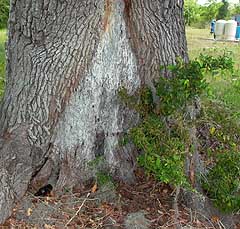Home > Tree structure basics > Lower trunk
Lower trunk

The lower trunk is where trunk tissue meets with root tissue. It receives all the mechanical stress from other portions of the tree canopy. It must be strong enough to hold the weight of the tree, even in windy weather. As a result, defects in this portion of the plant can result in catastrophic tree failure.
Very few trees have a smooth, perfect transition from trunk to root. Careful observation over a period of time can help you become familiar with the normal development on the common trees in your area. This is the best way to help diagnose problems on trees. The photo on the right shows a buried root flare (also called trunk flare). This can cause decay in the lower trunk and support roots.
See: More on trunk evaluation.
This swelling at the base of the tree is more or less normal trunk flare where roots transition into trunk. However, checking for decay in the center of the trunk using an appropriate device can help determine the stability of the tree.
The huge injury at the base of this large tree occurred several years ago. It can start a decline in tree health and lead to tree instability due to lack of roots on the affected side of the tree. Trees with this type of injury develop more wood on either side of the decay in an attempt to stabilize the trunk. You can see this if you look closely at the photo. Prevent further damage by mulching under the canopy to keep grass away. Reduce the size of or thin the canopy to reduce likelihood of failure in storms. |
This is one of the worst areas to inflict injury on trees. This can cause decay at the trunk base and can initiate cracks. Cracks and decay are major causes of tree failure and breakage. There is little that can be done to help this injury. Prevent further damage by mulching under the canopy to keep grass away. Keep mulch away from trunk. |




